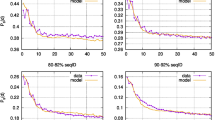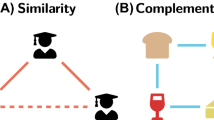Abstract
IT is sometimes desirable to study the possible relationship of two proteins when sequence data are unavailable. Few methods are useful for such an analysis: molecular size, functional criteria, genetic localization, end group analysis, tryptic fingerprints all have serious shortcomings. Immunological criteria may be useful when cross-reactivity is found, but such cross-reactivity is frequently one of the earliest common features to be lost. A possible useful criterion is amino-acid composition. Despite considerable changes in protein structure brought about by a limited number of sequence changes, the overall composition of evolutionary related proteins can be expected to remain quite similar. We wish to present a simple method for assessing and describing such compositional relatedness.
This is a preview of subscription content, access via your institution
Access options
Subscribe to this journal
Receive 51 print issues and online access
$199.00 per year
only $3.90 per issue
Buy this article
- Purchase on Springer Link
- Instant access to full article PDF
Prices may be subject to local taxes which are calculated during checkout
Similar content being viewed by others
References
Singer, S. J., and Doolittle, R. F., Science, 153, 13 (1966).
Hill, R. L., Delaney, R., Fellows, jun., R. E., and Lebovitz, H. E., Proc. US Nat. Acad. Sci., 56, 1762 (1966).
Tristram, G. R., and Smith, R. H., in The Proteins (edit. by Neurath, H.), second ed., 1, 45 (Academic Press, New York, 1963).
Tristram, G. R., and Smith, R. H., Adv. Prot. Chem., 16, 227 (1963).
Eck, R. V., and Dayhoff, M. O., Atlas of Protein Sequence and Structure (Nat. Biomed. Res. Found., Maryland, 1966).
Edelhoch, H., and Rall, J. E., in The Thyroid (edit. by Pitt-Rivers, R., and Trotter, W. R.), 113 (Butterworths, London, 1964).
Lowey, S., and Cohen, C., J. Mol. Biol., 4, 293 (1962).
Spahr, P. F., and Edsall, J. T., J. Biol. Chem., 239, 850 (1964).
Kassell, B., Radicevic, M., Berlow, S., Peanasky, R. J., and Laskowski, M., J. Biol Chem., 238, 3274 (1963).
Nyman, P. O., and Lindskog, S., Biochim. Biophys. Acta, 85, 141 (1964).
Laki, K., and Gladner, J. A., Physiol. Revs., 44, 127 (1964).
Cohen, S., and Porter, R. R., Adv. Immunol., 4, 287 (1964).
Fleischman, J. B., Porter, R. R., and Press, E. M., Biochem. J., 88, 220 (1963).
Allison, W. S., and Kaplan, N. O., J. Biol. Chem., 239, 2140 (1964).
Brew, K., Vanaman, T. C., and Hill, R. L., J. Biol. Chem., 242, 3747 (1967).
Author information
Authors and Affiliations
Rights and permissions
About this article
Cite this article
METZGER, H., SHAPIRO, M., MOSIMANN, J. et al. Assessment of Compositional Relatedness between Proteins. Nature 219, 1166–1168 (1968). https://doi.org/10.1038/2191166a0
Received:
Revised:
Issue Date:
DOI: https://doi.org/10.1038/2191166a0
This article is cited by
-
Isolation of novel metal-binding proteins distinct from metallothionein from spotted seatrout (Cynoscion nebulosus) and Atlantic croaker (Micropogonias undulatus) ovaries
Marine Biology (1991)
-
A fetuin-related glycoprotein (?2HS) in human embryonic and fetal development
Cell and Tissue Research (1987)
-
Structural homology between Drosophila melanogaster and Escherichia coli acidic ribosomal proteins
Biochemical Genetics (1984)
-
Chronic toxicity studies of crude organic chemical pollutants, illustrated by studies with Aroclor� 1254
Archives of Environmental Contamination and Toxicology (1983)
-
An analysis of amino acid composition of a few oxidoreductases by different methods
Bioscience Reports (1983)
Comments
By submitting a comment you agree to abide by our Terms and Community Guidelines. If you find something abusive or that does not comply with our terms or guidelines please flag it as inappropriate.



